The Superman Galaxy is a barred spiral galaxy located approximately 105 million light-years away in the northern constellation Pegasus. With an apparent magnitude of 11.6 and an apparent size of 4.1 by 3.1 arcminutes, it can be seen in amateur telescopes. The galaxy is listed as NGC 7479 in the New General Catalogue and Caldwell 44 (C44) in the Caldwell catalogue. It is also known as the Propeller Galaxy.
NGC 7479 stretches about 150,000 light-years across. It has been nicknamed the Superman Galaxy because the spiral arms of the galaxy, which rotate counter-clockwise, create the shape of a backward “S.”
NGC 7479 is classified as a Seyfert galaxy. It has an active galactic nucleus with a central supermassive black hole and an accretion disc. The black hole is feeding on the surrounding gas.
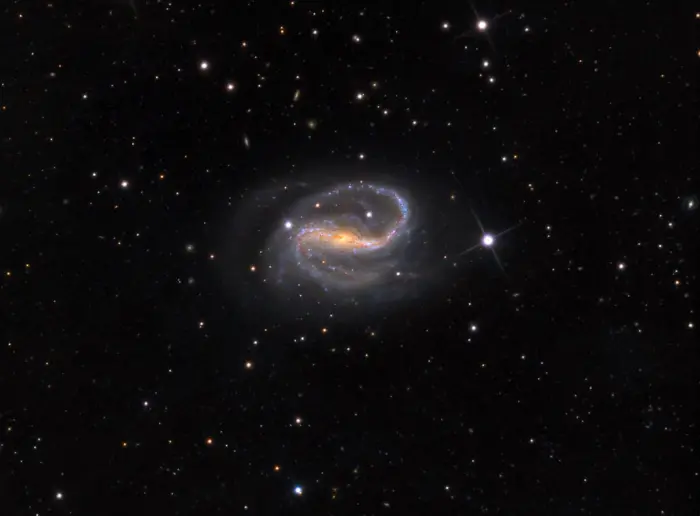
The Superman Galaxy (NGC 7479), image credit: Adam Block/Mount Lemmon SkyCenter/University of Arizona (CC BY-SA 3.0 US)
Like one-third of all nearby galaxies, NGC 7479 has a LINER nucleus (low-ionization nuclear emission-line region). The ionized gas in the galaxy’s core is powered either by the supermassive black hole or by star forming regions. Other well-known LINER galaxies include the Sombrero Galaxy (Messier 104) and Messier 90 in the constellation Virgo, the Black Eye Galaxy (Messier 64) in Coma Berenices, the Sunflower Galaxy (Messier 63), the Cat’s Eye Galaxy (Messier 94) and NGC 5005 in Canes Venatici, and the Fried Egg Galaxy (NGC 7742) in Pegasus.
Star formation in NGC 7479 occurs in the galaxy’s nucleus, across the bar, and in the outer spiral arms. Stars in the galaxy’s bar were mostly formed within the last 100 million years. Astronomers have observed the galaxy with the Hubble Space Telescope (HST) to study the star formation in it.
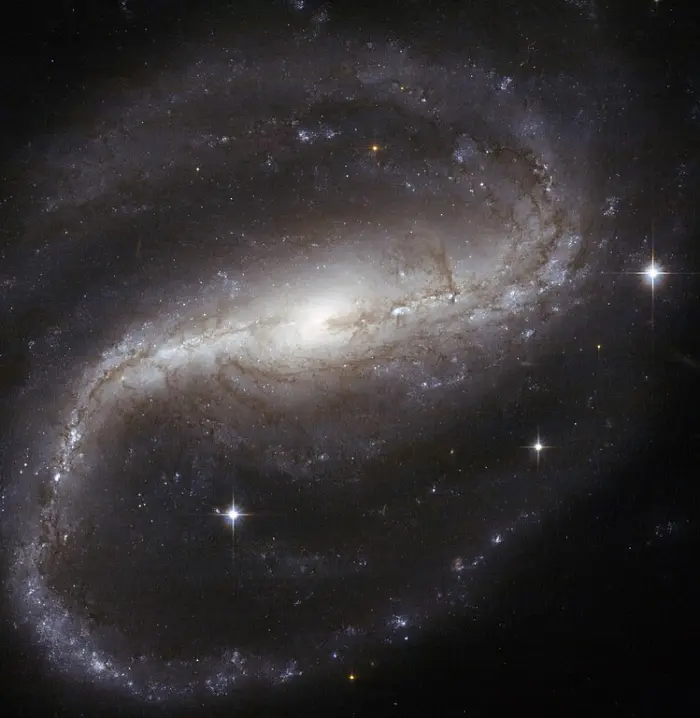
In this Hubble image of Caldwell 44, also known as NGC 7479, the tightly wound arms of the barred spiral galaxy create a backward “S” as they spin in a counter-clockwise direction. However, this galaxy, nicknamed the Propeller Galaxy, emits a jet of radiation in radio wavelengths that bends in the opposite direction to the stars and dust in the arms of the galaxy. Astronomers think that the radio jet was put into its bizarre backward spin after the Propeller Galaxy merged with another galaxy. The Propeller Galaxy is an interesting subject for several other reasons as well. Hidden within the galaxy’s core lurks a supermassive black hole that feeds on large quantities of gas. The galaxy has also been the home to two recent supernovae, one witnessed in 1990 and the other in 2009. Supernova events eject stellar material back into the cosmos to be used in subsequent generations of stars. The Propeller Galaxy is making rapid use of this recycled material as it undergoes starburst activity, with many bright, young stars peeking out of the spiral arms and disk. The three brightest stars in this image, however, are foreground stars — caught on camera because they lie between us and the galaxy. This image was taken in visible and infrared light with Hubble’s Advanced Camera for Surveys. The observations were taken to study the galaxy’s most recent supernova, SN 2009jf. Image credit: ESA/Hubble & NASA (CC BY 2.0)
A 2008 study found a jet-like radio continuum feature stretching across 39,139 light-years (12 kiloparsecs), that contains an aligned magnetic field. The jet of radiation in radio wavelengths was discovered during observations with the Very Large Array (VLA) and Effelsberg radio telescopes at four different wavelengths.
The observations provided evidence that there was a minor merger in the Superman Galaxy’s recent past. The radio jet is strongly interacting with the interstellar medium and it bends in the opposite direction to the stars and dust in the galaxy’s spiral arms, which may have been caused by a merger with a smaller galaxy. The galactic collision is also responsible for triggering intense starburst activity in NGC 7479.
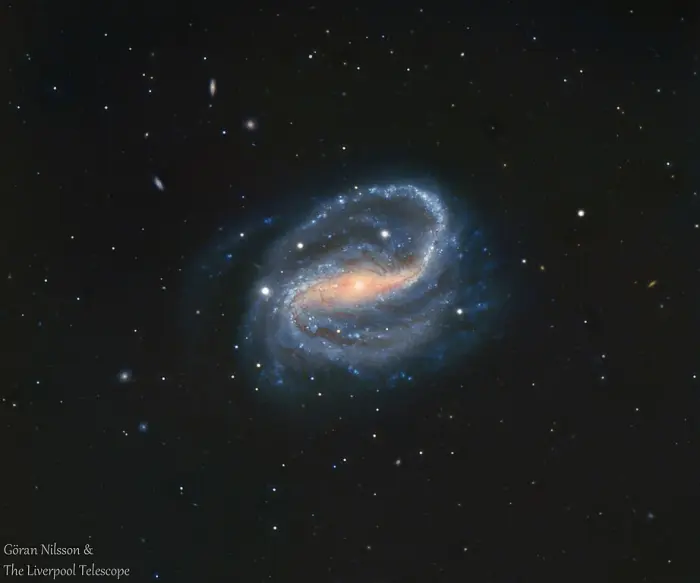
The Superman Galaxy (NGC 7479), image credit: Göran Nilsson & The Liverpool Telescope (CC BY-SA 4.0)
Facts
NGC 7479 was discovered by the German-born British astronomer William Herschel with an 18.7-inch reflector on October 19, 1784.
The Danish astronomer John Louis Emil Dreyer, who included the object in the New General Catalogue (NGC), described it as “pretty bright, considerably large, much extended 12°, between 2 stars.”
The Superman Galaxy hosted two supernovae in the recent decades. Discovered in 1990, SN 1990U was classified as a type Ic supernova and had an apparent magnitude of 16. In 2009, the type Ib supernova SN 2009jf shone at magnitude 18.
The Superman Galaxy looks very similar to the barred spiral galaxy NGC 1300 in the constellation Eridanus. NGC 1300 lies closer to us, at a distance of 61.3 million light-years, and has an apparent magnitude of 11.4. Unlike NGC 7479, NGC 1300 is not known to have an active galactic nucleus. The two galaxies have a similar size and morphology.
The galaxy NGC 7479 is one of the several deep sky objects in Pegasus that are listed in the Caldwell catalogue of objects visible in amateur telescopes, along with the spiral galaxies NGC 7331 (Caldwell 30) and the Little Sombrero Galaxy (NGC 7814, Caldwell 43).
The Superman Galaxy is also one of the Pegasus spiral galaxies included on the Herschel 400 observing list, along with NGC 7331, the Little Sombrero (NGC 7814), NGC 7217, and NGC 7448.
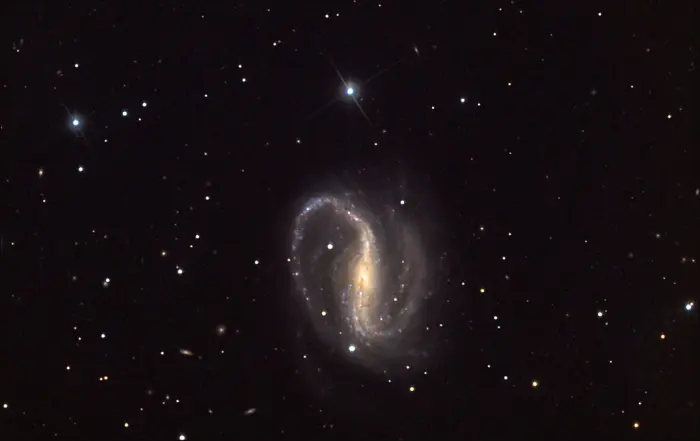
This fantastic barred spiral galaxy is located about 100 million lightyears away in Pegasus. This image was taken as part of Advanced Observing Program (AOP) program at Kitt Peak Visitor Center during 2014. Credit: KPNO/NOIRLab/NSF/AURA/Adam Block (CC BY 4.0)
Location
The Superman Galaxy lies in the constellation of Pegasus. It is fairly easy to find because it appears in the region of the Great Square of Pegasus. A line extended through the eastern stars of the Great Square – from Scheat (Beta Pegasi) through Markab (Alpha Pegasi) – leads to the galaxy. NGC 7479 appears 3 degrees south of Markab, the star at the southwestern corner of the asterism.
NGC 7479 can be seen in small and medium-sized telescopes, which will only show the galaxy’s elongated bar as an extended patch of light. The galaxy’s spiral arms can be spotted in larger instruments in exceptionally good conditions.
At declination +12°, NGC 7479 is visible from most locations for at least part of the year.
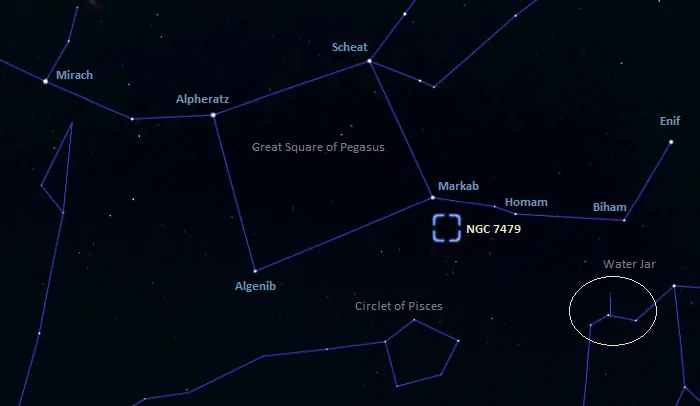
The location of the Superman Galaxy (NGC 7479), image: Stellarium
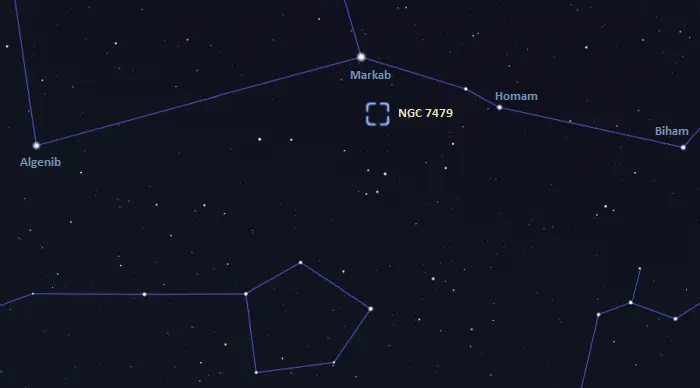
Superman Galaxy location, image: Stellarium
The best time of the year to see the Superman Galaxy and other deep sky objects in Pegasus is during the month of October, when the constellation is higher above the horizon in the early evening.
Superman Galaxy – NGC 7479
| Constellation | Pegasus |
| Object type | Barred spiral galaxy |
| Morphological type | SB(s)c |
| Right ascension | 23h 04m 56.6432243448s |
| Declination | +12° 19′ 22.357387020″ |
| Apparent magnitude | 11.6 |
| Apparent size | 4’.1 x 3’.1; 2’.470 x 0’.988 (near infrared) |
| Distance | 105 million light-years |
| Redshift | 2,122 ± 150 km/s |
| Diameter | ~150,000 light-years |
| Names and designations | Propeller Galaxy, Superman Galaxy, NGC 7479, Caldwell 44, C44, PGC 70419, LEDA 70419, UGC 12343, Z 430-58, Z 2302.4+1203, SWIFT J2304.9+1219, SWIFT J2304.7+1217, SWIFT J2304.9+1220, BWE 2302+1203, GB6 B2302+1203, 87GB 230227.1+120310, HIPASS J2304+12, K73 1004, IRAS F23024+1204, IRAS 2302+120P15, IRAS F23024+1203, IRAS 23024+1203, KUG 2302+120, MCG+02-58-060, 2MASX J23045666+1219223, 4PBC J2304.7+1219, MITG J230454+1219, NVSS J230456+121920, PBC J2304.8+1217, PSCz Q23024+1203, SDSS J230456.65+121922.3, UZC J230456.8+121927, WISE J230456.62+121922.7, 2XMM J230456.6+121921, Gaia DR3 2814761625511466624 |